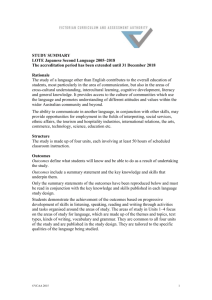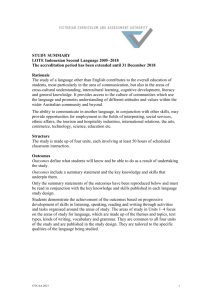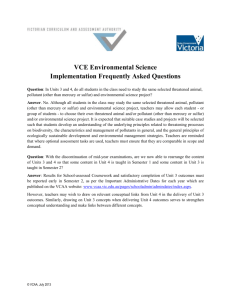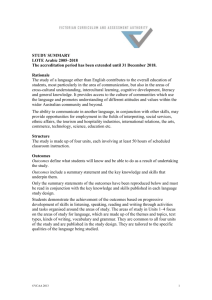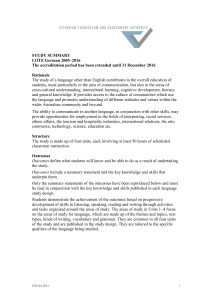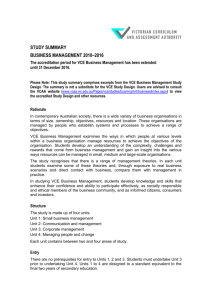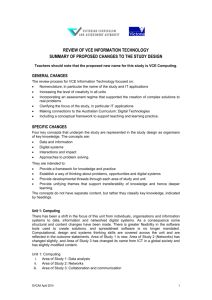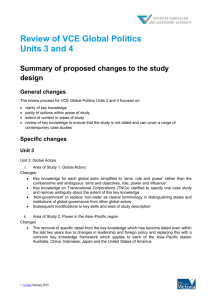Systems Engineering: 2013 School
advertisement
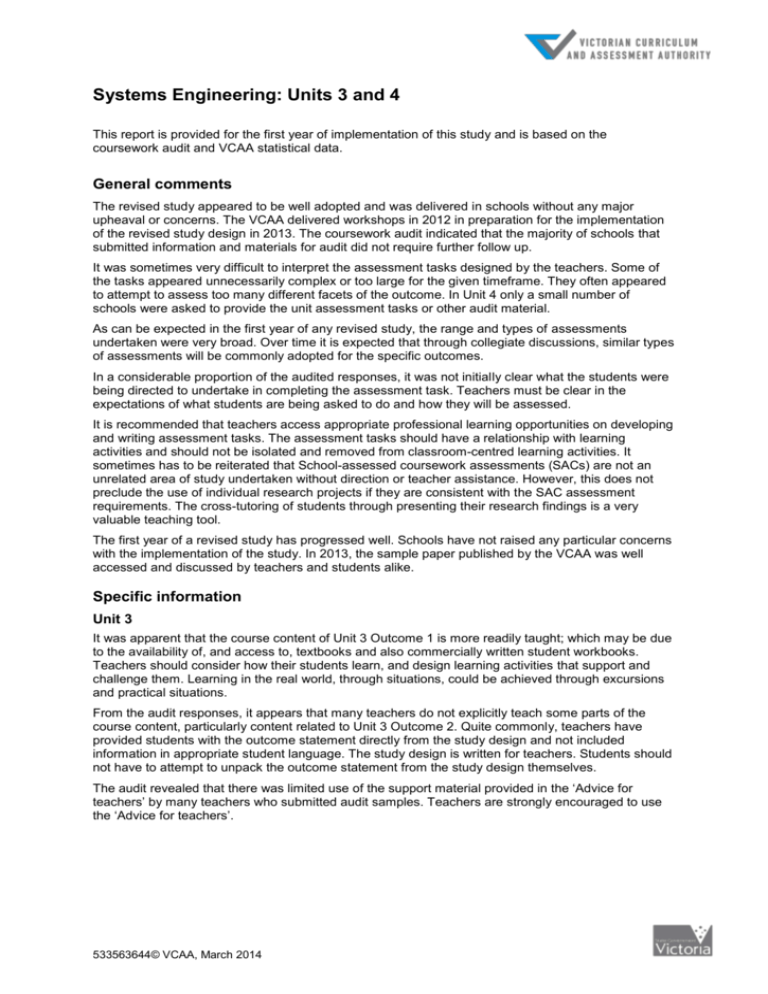
Systems Engineering: Units 3 and 4 This report is provided for the first year of implementation of this study and is based on the coursework audit and VCAA statistical data. General comments The revised study appeared to be well adopted and was delivered in schools without any major upheaval or concerns. The VCAA delivered workshops in 2012 in preparation for the implementation of the revised study design in 2013. The coursework audit indicated that the majority of schools that submitted information and materials for audit did not require further follow up. It was sometimes very difficult to interpret the assessment tasks designed by the teachers. Some of the tasks appeared unnecessarily complex or too large for the given timeframe. They often appeared to attempt to assess too many different facets of the outcome. In Unit 4 only a small number of schools were asked to provide the unit assessment tasks or other audit material. As can be expected in the first year of any revised study, the range and types of assessments undertaken were very broad. Over time it is expected that through collegiate discussions, similar types of assessments will be commonly adopted for the specific outcomes. In a considerable proportion of the audited responses, it was not initially clear what the students were being directed to undertake in completing the assessment task. Teachers must be clear in the expectations of what students are being asked to do and how they will be assessed. It is recommended that teachers access appropriate professional learning opportunities on developing and writing assessment tasks. The assessment tasks should have a relationship with learning activities and should not be isolated and removed from classroom-centred learning activities. It sometimes has to be reiterated that School-assessed coursework assessments (SACs) are not an unrelated area of study undertaken without direction or teacher assistance. However, this does not preclude the use of individual research projects if they are consistent with the SAC assessment requirements. The cross-tutoring of students through presenting their research findings is a very valuable teaching tool. The first year of a revised study has progressed well. Schools have not raised any particular concerns with the implementation of the study. In 2013, the sample paper published by the VCAA was well accessed and discussed by teachers and students alike. Specific information Unit 3 It was apparent that the course content of Unit 3 Outcome 1 is more readily taught; which may be due to the availability of, and access to, textbooks and also commercially written student workbooks. Teachers should consider how their students learn, and design learning activities that support and challenge them. Learning in the real world, through situations, could be achieved through excursions and practical situations. From the audit responses, it appears that many teachers do not explicitly teach some parts of the course content, particularly content related to Unit 3 Outcome 2. Quite commonly, teachers have provided students with the outcome statement directly from the study design and not included information in appropriate student language. The study design is written for teachers. Students should not have to attempt to unpack the outcome statement from the study design themselves. The audit revealed that there was limited use of the support material provided in the ‘Advice for teachers’ by many teachers who submitted audit samples. Teachers are strongly encouraged to use the ‘Advice for teachers’. 533563644© VCAA, March 2014 Unit 3 Outcome 1 School-assessed Task (SAT) Investigate, analyse and use advanced mechanical-electrotechnology integrated and control systems concepts, principles and components, and using selected relevant aspects of the Systems Engineering Process, design, plan and commence construction of an integrated and controlled system. Students are assessed for Outcome 1 on the following: The School-assessed Task contributes 50 per cent to the study score and is commenced in Unit 3 and completed in Unit 4. Nature of task A record of investigation, design, planning and production. AND Preliminary production work. In viewing the range of audit responses, it was apparent that the assessment of Unit 3 was commonly quite misunderstood and that many teachers were still using elements of assessment from the previous study design. It was also quite common for teachers to submit assessment tasks, usually in the form of a test, as examples of assessment of Outcome 1 – this being the components of the fundamental physics, concepts and principles that underpin key knowledge and skills of Systems Engineering and part of the SAT. While it is necessary for teachers to explicitly teach the content of the key knowledge in Outcome 1, and provide activities to allow students to demonstrate the key skills, it is essential teachers realise this content relates to the SAT and it is not appropriate to be included in their School-based Assessment. However, the testing and measuring of students’ understanding of this outcome through practical tasks is acceptable, particularly in relation to providing informative feedback to the students about their own learning. Unit 3 Outcome 2 School-assessed Coursework Discuss the advantages and disadvantages of renewable and non-renewable energy sources, and analyse and evaluate the technology used to harness, generate and store non-renewable and renewable energy. Assessment tasks for this outcome are any one or a combination of: a test (short and/or extended responses) a short written report a report in multimedia format a media analysis a case study an oral presentation. The audit showed that schools conducted this assessment using a variety of forms. Commonly this assessment was undertaken as a written report, while some schools offered students the option to complete a report in a multimedia format. A couple of respondents to the audit indicated that the students were required to complete a report and undertake formal testing as well. Commonly teachers referred to using the assessment handbook when developing the tasks and attempted to align assessment using the weightings as suggested. It was very common for schools to modify the published assessment criteria. It appeared that schools, in responding to the audit survey, almost felt duty bound not to directly apply the published assessment performance descriptors, but rather modify and customise them. VCE Systems Engineering: 2013 School-assessed Coursework Report © VCAA, March 2014 2 The few schools that proceeded to have follow-up audit stages overwhelmingly provided the impression that the teacher designed assessment tasks were written too much in isolation, generally being poorly linked or related to the coursework content. In these situations teachers too often made the assumption that their students were strong self-directed learners. It raised the concern that for some students this may be possible, but for many the perceived vacuum of related teaching and context for the task could be quite daunting and would not facilitate good learning or comprehension of the study. Future audit surveys should phrase and structure questions that are very clear and easily understood by the teachers. These questions should tease out the nature of the task and allow teachers to clearly articulate the ground-work covered and the leaning and preparation that preceded any one of the coursework assessments. Some of the specific questions related to the assessment task could include: the preparation, background and setup of the task the context of how it will be undertaken the time allocation – just to undertake the assessment task (some tasks appeared to be assessed over weeks or even months) the level of support provided, both the physical equipment and resources available and the directed or supported learning offered. The teaching of the key knowledge and key skills was best achieved through school excursions, field trips and other industry-based activities. The teaching of the key knowledge was particularly difficult if the students were contained to only the classroom experience, although very relevant and informative videos are now available. The way that the key knowledge in this outcome is taught will continue to improve over the coming years as best practice is more widely adopted. Unit 4 Coursework Unit 4 Outcome 1 Produce, test and diagnose an advanced mechanical-electrotechnology integrated and controlled system using selected relevant aspects of the Systems Engineering Process, and manage, document and evaluate the system and processes. Assessment tasks Production work accompanied by a record of progress and modifications (pictorial and text material). AND A report of diagnostic testing and performance data. AND A report that evaluates and suggests improvements to the student’s use of the Systems Engineering Process, and the operational system with reference to the factors that influenced its development and use. Teachers provide the VCAA with a single score representing an assessment of the student’s level of performance in achieving Outcome 1 in Unit 3 and Outcome 1 in Unit 4. The score must be based on the teacher’s assessment of the student’s performance according to the criteria published each year in the Administrative advice for School-based Assessment document on the VCE study page on the VCAA website. The set of criteria for the award of grades is the sole basis for the assessment of the School-assessed Task. The completed assessment sheet for each student’s School-assessed Task must be available on request by the VCAA. Details of authentication requirements and administrative arrangements for the School-assessed Task will be published annually in the ‘Administrative advice for School-based Assessment’ document, and the current year’s VCE and VCAL Administrative Handbook. VCE Systems Engineering: 2013 School-assessed Coursework Report © VCAA, March 2014 3 Unit 3 Outcome 1 and Unit 4 Outcome 1 Production – School-assessed Task Unit 3 Outcome 1 and Unit 4 Outcome 1 apply to the School-assessed Task (SAT) and are assessed using the VCAA published assessment criteria for the year of the assessment. No other local, schooldeveloped or modified assessment criteria can be used when assessing this production task. The audit indicated schools were using the correct 2013 assessment criteria for the current year. It should be noted that teachers should always ensure that they access the School-assessed Task assessment criteria every year as the criteria can be slightly modified year on year, with either subtle or more significant changes being made. It was apparent in the survey responses that a number of schools were still formally assessing the key knowledge elements of Outcome 1 as a School-assessed Coursework task. This assessment related to the previous Systems Engineering study design, which concluded in 2012. It would seem that a number of schools were not aware of this significant restructure within the current study design. Though not required, the schools that conducted formal SAC type tasks for Outcome 1, generated something akin to SAC results data. It was not stated or made clear how these ‘results’ would be used or how they may be apportioned, which raises the concern that a proportion of the informal assessments would be somehow incorporated into the final end-of-year School-assessed Task score or alternatively be proportionally included in the Outcome 2 School-assessed Coursework score for Unit 3. It is acknowledged that students will need to be provided with extensive teaching and learning activities, which may include tests and other forms of informal assessments to check and determine students understanding of the topics. The audit showed the use of commercially available texts and student workbooks is very common. These types of resources can assist students in structuring their learning and can be a useful teaching tool. However, over-reliance on these materials is no substitute for actual hands-on experiences or structured learning activities such as industry tours or excursions. A couple of the audit responses suggested that the completion of the commercially available workbooks would form some part of the assessment, but once again were not specific about how this assessment could actually be applied. The audit showed some schools closely structure the progressive submission of the elements that make up the complete project (School-assessed Task). This technique was generally well supported and directly aligned to the student’s Authentication Record Form. Teachers are required to regularly monitor student work and regularly maintain the: Authentication Record Form Teacher Addition Comment Sheet School-assessed Task Assessment Sheet for each student, on completion of the task. The VASS data entry requires a numeric score for each criterion. The authentication documentation is particularly supportive in the process of checking off the submission of the various components that form the School-assessed Task. These specific documents can be requested as part of the audit process. All these documents are published annually by the VCAA and are accessible at: www.vcaa.vic.edu.au/Pages/vce/studies/systemseng/systemsengindex.aspx. Although maintaining photographic records of the student productions is not mandated, it is useful for teachers to refer to when undertaking assessments. Conducting the School-assessed Task In 2013, the production School-assessed Tasks were undertaken in a very similar manner to the previous years. A very diverse range of controlled integrated systems were designed, constructed, tested and evaluated using the Systems Engineering Process in the period from February to October 2013. The level of project management and effective application of the Systems Engineering Process of every individual student was a significant determining factor in the level of success of each student. A couple of schools were required to clarify specific projects that outwardly, from the provided description, appeared to be non-integrated systems. This clarification was achieved through supplying the design briefs and initial plans of the productions in question. In every case the clarification confirmed that the intended projects were in fact controlled integrated systems. VCE Systems Engineering: 2013 School-assessed Coursework Report © VCAA, March 2014 4 The observation is that smaller numbers of students are doing automotive, car and motor bike engine restoration or modification related tasks. The requirement in the current study design for extensive risk assessment at all stages has drawn attention to these higher risk activities. Some safety concerns were raised in the audit if teachers indicated that students were either planning to build significantly powered motorised vehicles, work on the actual wiring of mains connected 240-volt equipment or plan to significantly use restricted machinery in the production process. It is always recommended, where possible, that students opt to use the equipment from the ‘Safer Machinery list’. Any process that is dangerous, or if a school does not have the appropriate facilities to effectively and safely carry out the task, should be outsourced to a professional supplier. Examples of this could be to supply cut glass, or have a licensed electrician undertake mains power wiring, and then securely sealing these connections in order that no student access can be made to mains power connections. Allowing students to work only on the low-voltage portion of circuits is another option. Wellbeing and safety information including specific electrical compliance advice is provided on pages 8 and 9 of the study design: www.vcaa.vic.edu.au/Documents/vce/technology/SystemsEngineeringSD-2013.pdf The Department of Education and Early Childhood Development (DEECD) also provides advice to schools and teachers about the safe use of machinery and plant which can be found at: School Policy and Advisory Guide: www.education.vic.gov.au/school/principals/spag/Pages/spag.aspx Use of machinery in technology teaching: www.education.vic.gov.au/school/principals/management/Pages/technology.aspx Unit 4 Outcome 2 Describe and evaluate a range of new or emerging technologies, and analyse the likely impacts of a selected innovation. Assessment Assessment tasks for this outcome are any one or a combination of the following: a test (short and/or extended responses) a short written report a report in multimedia format a media analysis a case study an oral presentation. The conducting of this assessment was very similar to the Unit 3 Outcome 2 assessment. A small number of schools were audited and were required to provide copies of the task as provided to the students and the assessment descriptors that were used in the assessment process. The few schools that were asked to provide their tasks were vague and quite non-descript in what the task was actually directing the students to do. In these cases reading the task description multiple times, and with significant liberty of interpretation and assumption being taken, it was possible to establish what the students were required to do for the assessment. The greater majority of schools were quite clear in the intent of the type of assessment task to be undertaken. Commonly, this was a short written report in the form of a research-based task, in which one or more new technologies were investigated and reported on. When this task was developed it was not envisaged that any limits would be applied to the range and number of new and emerging technologies that could be considered. The structure of the outcome was intentionally not at all confined. It was also expected that over the accredited life of the study design that what constituted new and emerging technologies would also evolve and change. By default a number of schools consistently settled on 10 specific new technologies, with the number of specific technologies related to Google searches and what was produced. Both teachers and students seemed to be unaware that this was an artificial constraint to be imposed, but limiting the number to 10 new technologies certainly had merit. Depending on how the assessment task was structured, it would be very reasonable for students to report on a single new technology. VCE Systems Engineering: 2013 School-assessed Coursework Report © VCAA, March 2014 5 The VCE Systems Engineering Assessment Handbook 2013–2017 advises that teachers should develop assessment tasks that allow the student to: analyse and compare the benefits, limitations and impacts of renewable and non-renewable energy sources explain recent technological developments to reduce carbon emissions, and improve efficiency and the environmental credentials of non-renewable resources describe and diagrammatically represent the technologies and processes used to harness, generate and store renewable energy sources describe the factors that determine the efficiency of energy conversion investigate and evaluate new technologies and compare these methods of harnessing energy with non-renewable energy methods describe the energy transformations through the life cycle of power supply, including harnessing or extraction, generation, conversion, transportation, storage and use. The audit responses provided a range of ways that the School-based Assessment for Unit 4 Outcome 2 was achieved – the written report appeared to be most common. Students were often provided with a very broad statement, directly derived from the outcome statement from the study design. However, a more suitable technique was providing students with a series of structured high-level questions. A couple of audit responses had an extensive written report and additional structured testing; however the testing component questions related to Outcome 1. In the majority of cases, it could be assumed, although not explicitly stated, that the assessment tasks were developed with reference to the published VCAA assessment descriptors from the assessment handbook. In addition, many teachers supplied separate assessment descriptors, usually in the form of an assessment rubric that was an adaptation of the VCAA published descriptors. Teachers who modified and/or developed their own assessment descriptors need to ensure that the weightings that were developed by them and used for assessment consistent with the study design. For ease of calculation, the number of potential marks allocated should total 50 marks, allowing the score to be reported on VASS. In a number of incidences provided in the audit sample, the assessment was too complex and included assessment that was well outside the scope of this outcome. Commonly, an over-reliance on using unrelated old examination questions from the previous study design was evident. Teachers are better advised to use the published VCAA performance descriptors. VCE Systems Engineering: 2013 School-assessed Coursework Report © VCAA, March 2014 6
